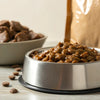How to Wean Your Dog Off Wet Food: A Comprehensive Guide
- Houndsy
Table of Contents
- Introduction
- Understanding the Reasons for Transitioning
- Preparing for the Transition
- Strategies for Comfort During the Transition
- Addressing Challenges During Transition
- Long-Term Feeding Strategies
- The Houndsy Kibble Dispenser: Elevating Mealtime
- Conclusion
Introduction
Have you ever noticed how dogs can be quite picky when it comes to their food? According to a survey conducted by the American Kennel Club, around 47% of dog owners report their pets preferring wet food over dry kibble. While wet food may be a great choice for many dogs, there can be myriad reasons you might want to transition your furry friend away from it. Whether it’s due to dietary requirements, cost considerations, or a desire for convenience, understanding how to effectively wean your dog off wet food can significantly improve your feeding routine.
In this blog post, we will explore the step-by-step process of transitioning your dog from wet food to dry kibble, enhancing not only your pup's dining experience but also aligning with your lifestyle. We'll cover essential tips and tricks, common challenges of making the switch, strategies for maximum success, and how to maintain your dog’s well-being throughout this transition.
By the end of this guide, you will feel empowered to embark on this journey with your dog, ensuring their dietary needs are met while promoting a healthier feeding routine. Let’s dive in and discover how we can make mealtime work better for both you and your canine companion!
Understanding the Reasons for Transitioning
Before we plunge into the specifics of the weaning process, let’s discuss why you may want to make this change. Here are some of the most common reasons:
-
Health Considerations: Some dogs may require a diet low in moisture due to health issues like kidney problems or obesity, where dry food can provide a more controlled calorie intake.
-
Cost Efficiency: Dry dog food is often more affordable than wet food. If you're looking to save on pet expenses, transitioning might be beneficial.
-
Convenience: Dry kibble is easier to store, measure, and serve without worrying about spoilage. For busy pet owners, this is a practical advantage.
-
Dental Health: Dry food can aid in dental health by helping to scrape plaque off teeth during chewing, something wet food may not be able to achieve.
-
Puppy to Adult Transition: As dogs mature, their dietary needs also change. Adult dogs may require different nutritional profiles than those provided by wet food.
Understanding your motivation will not only help you shape a plan but also keep you focused during the transition process.
Preparing for the Transition
Transitioning your dog off wet food requires careful planning. Let’s walk through the essential steps.
Consult Your Veterinarian
Before making any dietary changes, it’s essential to consult with your veterinarian. They can provide tailored advice based on your dog’s health, age, and activity level, ensuring the switch aligns with their specific nutritional needs.
Selecting the Right Dry Food
Choosing a high-quality dry dog food that meets your dog’s nutritional needs is crucial. Look for brands that use real meat as the primary ingredient and are free from unnecessary fillers. It’s helpful to familiarize yourself with the ingredient label and guarantee analysis to ensure you’re providing a balanced diet.
Gradual Transition Plan
Transitioning your dog off wet food should be a gradual process to minimize digestive upset. The following is a general timeline to help ensure your pup adjusts smoothly:
- Days 1-2: Start with a mixture of 75% wet food and 25% dry food.
- Days 3-4: Shift to 50% wet food and 50% dry food.
- Days 5-6: Change to 25% wet food and 75% dry food.
- Day 7: Offer 100% dry food.
Remember, some dogs may take longer to adjust, so be patient. If your dog shows signs of distress, go back to the previous ratio and proceed more slowly.
Strategies for Comfort During the Transition
Helping your dog feel comfortable during this change is essential. Here are some strategies you might consider:
Make the Dry Food Palatable
To encourage your dog to eat dry food, consider the following tips:
- Mix it Up: Add warm water or low-sodium broth to the kibble to enhance aroma and palatability.
- Toppers: Incorporate a small amount of wet food or a healthy treat on top of dry food to make the transition less jarring.
- Hand-feeding: Sometimes, offering kibble from your hand can entice hesitant eaters to give it a try.
Establish a Feeding Routine
Implementing a structured feeding schedule can help your dog adjust to the new routine. This includes:
- Scheduled Meals: Move away from free feeding to defined meal times.
- Meal Limits: Allow your dog about 20 minutes to eat before removing any uneaten food.
By making mealtime predictable, your pup can associate feeding with comfort and routine.
Addressing Challenges During Transition
Many pet owners encounter issues during dietary changes. Here are some common challenges and solutions:
Food Refusal
If your dog refuses to eat the new kibble, don’t be alarmed. This is common during transitions. You might try:
- Feeding Smaller Portions: If your dog is overwhelmed, giving smaller quantities might help.
- Finicky Eaters: For dogs that have been primarily fed wet food, introducing various dry food flavors can keep them interested.
Digestive Upsets
Be vigilant about your dog’s stool and overall digestive health. Signs of digestive upset can include diarrhea or vomiting, indicating a need for a slower transition. If problems persist for more than a couple of days, consult your veterinarian.
Weight Management
Switching to dry food can also influence your dog's weight. Monitor their weight regularly and ensure you’re adhering to feeding guidelines offered on the food packaging. Adjust portion sizes as necessary to maintain a healthy weight.
Long-Term Feeding Strategies
Once your dog has completely transitioned to dry food, it's essential to continue focusing on their dietary needs. Here are a few long-term strategies:
Regular Vet Check-ups
Regular veterinary visits can help ensure your dog remains healthy and that their dietary needs still align with their activities and health status.
Rotate Protein Sources
To keep meals interesting and avoid food sensitivities, consider rotating between different protein sources such as chicken, beef, lamb, or fish.
Monitor Weight and Health
Keep an eye on your dog's weight and adjust feeding amounts as necessary, especially as their activity levels change.
The Houndsy Kibble Dispenser: Elevating Mealtime
A smooth feeding routine can be effortlessly achieved with the right tools. Here at Houndsy, we understand the significance of convenience and aesthetics in pet care. Our flagship product, the Houndsy Kibble Dispenser, is designed to simplify your daily feeding experience.
- Perfect Portion Control: The dispenser lets you easily deliver the ideal serving size without mess, making feeding time efficient and straightforward.
- Beautiful Design: With a mid-century modern aesthetic, the dispenser not only serves functionality but also complements your home décor.
- Ergonomic Convenience: No need to bend down or struggle—our dispenser operates at a comfortable standing height.
Whether you're transitioning your dog off wet food or just aiming to enhance mealtime, the Houndsy Kibble Dispenser will fit seamlessly into your feeding routine. Explore the product here.
Conclusion
Transitioning from wet food to dry food doesn’t have to be an overwhelming experience. With careful planning and a gradual approach, we can foster a successful dietary change that benefits both you and your dog. By keeping an open line of communication with your veterinarian, selecting quality dry food, and implementing gradual stages, we are well-equipped to handle any challenges that arise along the way.
As we conclude this guide on how to wean your dog off wet food, we encourage you to reflect on your own feeding practices. Perhaps you can adjust routines to focus more on your dog’s preferences or allow them to explore new foods and flavors.
For your next feeding upgrade, consider incorporating the Houndsy Kibble Dispenser and improve your pet care routine today! Visit our product page here to make mealtime moments truly special.
Frequently Asked Questions
How long does it take to transition my dog off wet food?
The transition can take anywhere from one to two weeks, depending on your dog’s sensitivity to food changes. A gradual approach is crucial for a successful transition to avoid digestive upset.
What if my dog refuses to eat dry food?
If your dog is resistant to eating dry food, try mixing it with a small amount of wet food or warm water to enhance the aroma. If this doesn’t work, consider evaluating the type of dry food you’re offering.
Can I mix wet and dry food together during the transition?
Yes, initially combining wet and dry foods can help ease the dog into the new texture while they adapt. Begin with a higher ratio of wet food, gradually reducing it as your dog acclimates.
What signs should I look for to know if my dog is having issues with the transition?
Monitor your dog for any changes in appetite, vomiting, diarrhea, or lethargy. If these symptoms persist for more than a couple of days, consult your veterinarian.
Will my dog’s coat change when switching to dry food?
Improper nutrition can impact your dog’s coat health. Transitioning to high-quality dry food may illuminate improvements in coat quality, but it’s essential to ensure overall balanced nutrition. If you notice adverse changes, consult your vet.
We’re excited for you and your dog as you embark on this new feeding journey!












